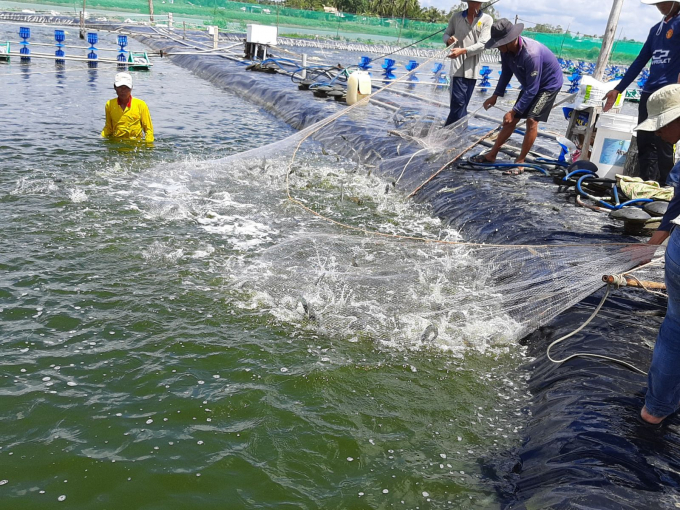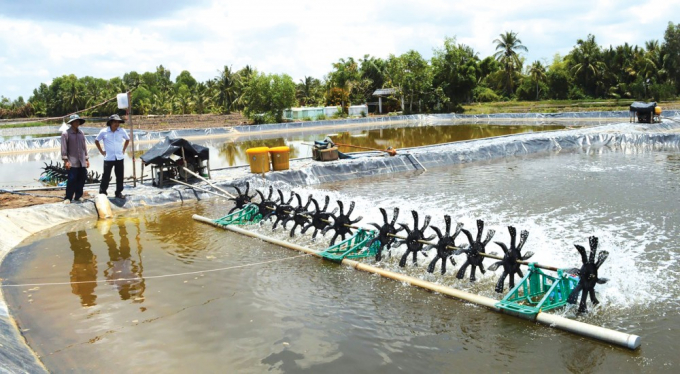Khanh Hoa province applys high technology in shrimp farming
(VAN) For the 2022 brackish water shrimp farming season to be successful, Khanh Hoa province has announced a
According to the General Department of Fisheries, in 2020, over 46,000 ha of the country’s total aquaculture area were damaged by epidemic diseases (an increase by 1.9 times compared to 2019). About 10,000 aquaculture cages and rafts were destroyed.
Specifically, more than 43,300 ha of brackish water shrimp breeding suffered from destruction, equal to 94% of the total damaged area, 2 times higher than in 2019, and accounting for nearly 6% of the country’s total shrimp area. Although the affected area is not large, it has caused losses to farmers.
In Mekong Delta, drought and saline intrusion are increasingly causing many obstacles for aquaculture. Photo: TL.
Therefore, the strengthening of management solutions, as well as the application of new processes and technical advances in shrimp farming is a matter of special concern to limit to a minimum the risks of damages caused by climate change and environmental pollution. The solution should be carried out in the direction of disease safety, quality, and harmony with the ecological environment across the country in general and the Mekong Delta in particular.
Mr. Kim Van Tieu, former deputy director of the National Agricultural Promotion Center (NAPC) said due to the erratic climate, shrimp and fish farming is very unpredictable because shrimp and fish are cold-blooded animals and they are very sensitive to temperature and environment. Sudden changes in weather, temperature, etc. can cause fish and shrimp to die immediately or reduce resistance, creating opportunities for viruses and bacteria to attack, thus leading to disease outbreaks. Meanwhile, viral diseases cause a mortality rate of up to 100%.
In the Mekong Delta provinces, drought and saline intrusion also cause many difficulties for aquaculture. When a saline intrusion occurs, not only people's lives are turned upside down, but fish cages are very susceptible to salt shock and death. In shrimp farming, high salinity will slow down the growth of shrimp and cause disease attacks, resulting in great losses.
According to Tieu, over the years, aquaculture has made a lot of progress, in which a turning point is seen in the application of microbiological technology. When farmers want to have high productivity with good quality, reduce product costs, ensure food safety, and associated with environmental protection, there is no other way but to use microbial products.
If shrimp farmers want to gross high productivity, have good quality, lower product costs, and protect the environment, they have no choice but to use microbial products. Photo: TL.
On that basis, the NAPC has cooperated with many companies, including Bo De Fisheries Group Joint Stock Company (Bo De Company) to quickly transfer scientific and technical advances to farmers.
Currently, microbial products are used in 2 forms: putting them into the water environment and mixing with food. Statistics show that in farming models using microbial products, the survival rate of shrimp is very high, the shrimp grow quickly thus helping shorten the farming time and better ability to shrimp in absorbing food, so the feed coefficient is reduced...
“If growers do not use microbial products, they usually lose about 1.2 - 1.3 kg of feed to grow 1kg of commercial shrimp. When using the products, the amount of food is reduced to only 1.1 kg," said Tieu.
Regarding mechanisms and policies, Tieu said more investment funds should be for support education and training. There should be policies to support businesses so that they can accompany farmers and help them grasp the market trend as well as lead sustainable production.
In addition, it is necessary to develop regional planning with more State supports in building roads, electricity, water supply, drainage systems, and reservoirs of both salt and fresh water... Specialized agencies need to strengthen their management to ensure adequate quality breeds and environmental treatment products reach farmers.
Mr. Tieu also mentioned some issues in off-season shrimp farming saying that in the North when growing shrimp during winter, farmers are required to have a house to keep the temperature of the pond in balance with the weather outside. In terms of potential, shrimp farming in the winter season is not much so the selling price is usually 1.5 - 2 times higher than that of the main crop. The most important thing is that shrimp must be disease-free and easy to consume.
According to Mr. Tieu, the difficulty of shrimp farming in the off-season is that the pond should have to be lined with tarpaulins, covered by a roof and with aeration, etc., so the initial investment costs are large. When farming shrimp in the off-season, farmers need to pay attention to preparing the pond carefully and synchronously. If not using biological products, they must build a tarpaulin house, lined with canvas, aerator, fan, water supply, and drainage ditch. Water should also be stored, treated well before leasing into the pond...
At the same time, it is necessary to apply the 2-stage shrimp farming technique. Firstly, release the shrimp into the tank for 25-30 days. When the shrimp grow up and have adequate resistance against disease, release them into the big pond. Besides, as weather in winter is often cold, if it is below 18 degrees Celsius, stop feeding shrimp, because the excess food when the weather warms up may easily cause the water to rot, pollute, causing "shrimp and fish to die not of hunger but of excessing food”.
Translated by Huy Son

